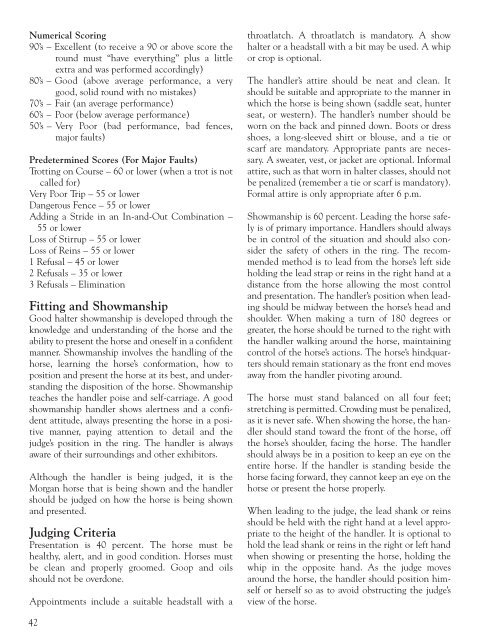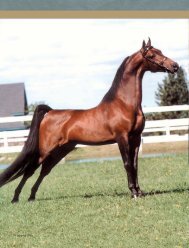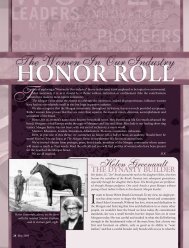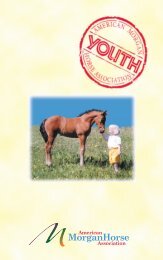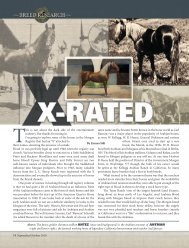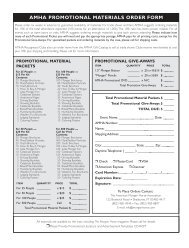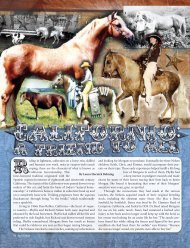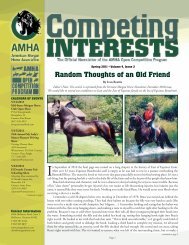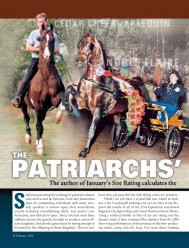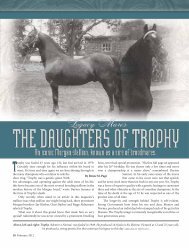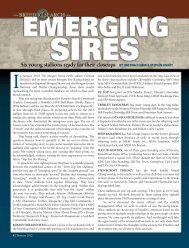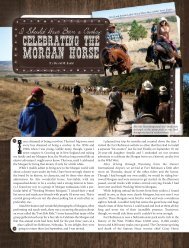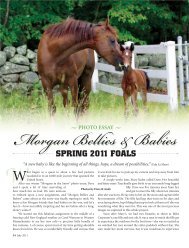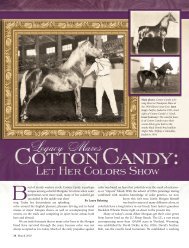Judging School Handbook - American Morgan Horse Association
Judging School Handbook - American Morgan Horse Association
Judging School Handbook - American Morgan Horse Association
Create successful ePaper yourself
Turn your PDF publications into a flip-book with our unique Google optimized e-Paper software.
Numerical Scoring90’s – Excellent (to receive a 90 or above score theround must “have everything” plus a littleextra and was performed accordingly)80’s – Good (above average performance, a verygood, solid round with no mistakes)70’s – Fair (an average performance)60’s – Poor (below average performance)50’s – Very Poor (bad performance, bad fences,major faults)Predetermined Scores (For Major Faults)Trotting on Course – 60 or lower (when a trot is notcalled for)Very Poor Trip – 55 or lowerDangerous Fence – 55 or lowerAdding a Stride in an In-and-Out Combination –55 or lowerLoss of Stirrup – 55 or lowerLoss of Reins – 55 or lower1 Refusal – 45 or lower2 Refusals – 35 or lower3 Refusals – EliminationFitting and ShowmanshipGood halter showmanship is developed through theknowledge and understanding of the horse and theability to present the horse and oneself in a confidentmanner. Showmanship involves the handling of thehorse, learning the horse’s conformation, how toposition and present the horse at its best, and understandingthe disposition of the horse. Showmanshipteaches the handler poise and self-carriage. A goodshowmanship handler shows alertness and a confidentattitude, always presenting the horse in a positivemanner, paying attention to detail and thejudge’s position in the ring. The handler is alwaysaware of their surroundings and other exhibitors.Although the handler is being judged, it is the<strong>Morgan</strong> horse that is being shown and the handlershould be judged on how the horse is being shownand presented.<strong>Judging</strong> CriteriaPresentation is 40 percent. The horse must behealthy, alert, and in good condition. <strong>Horse</strong>s mustbe clean and properly groomed. Goop and oilsshould not be overdone.Appointments include a suitable headstall with athroatlatch. A throatlatch is mandatory. A showhalter or a headstall with a bit may be used. A whipor crop is optional.The handler’s attire should be neat and clean. Itshould be suitable and appropriate to the manner inwhich the horse is being shown (saddle seat, hunterseat, or western). The handler’s number should beworn on the back and pinned down. Boots or dressshoes, a long-sleeved shirt or blouse, and a tie orscarf are mandatory. Appropriate pants are necessary.A sweater, vest, or jacket are optional. Informalattire, such as that worn in halter classes, should notbe penalized (remember a tie or scarf is mandatory).Formal attire is only appropriate after 6 p.m.Showmanship is 60 percent. Leading the horse safelyis of primary importance. Handlers should alwaysbe in control of the situation and should also considerthe safety of others in the ring. The recommendedmethod is to lead from the horse’s left sideholding the lead strap or reins in the right hand at adistance from the horse allowing the most controland presentation. The handler’s position when leadingshould be midway between the horse’s head andshoulder. When making a turn of 180 degrees orgreater, the horse should be turned to the right withthe handler walking around the horse, maintainingcontrol of the horse’s actions. The horse’s hindquartersshould remain stationary as the front end movesaway from the handler pivoting around.The horse must stand balanced on all four feet;stretching is permitted. Crowding must be penalized,as it is never safe. When showing the horse, the handlershould stand toward the front of the horse, offthe horse’s shoulder, facing the horse. The handlershould always be in a position to keep an eye on theentire horse. If the handler is standing beside thehorse facing forward, they cannot keep an eye on thehorse or present the horse properly.When leading to the judge, the lead shank or reinsshould be held with the right hand at a level appropriateto the height of the handler. It is optional tohold the lead shank or reins in the right or left handwhen showing or presenting the horse, holding thewhip in the opposite hand. As the judge movesaround the horse, the handler should position himselfor herself so as to avoid obstructing the judge’sview of the horse.42


